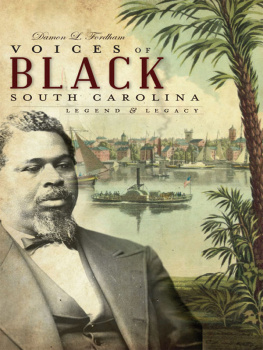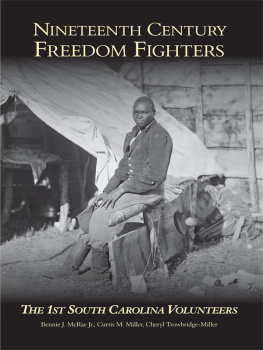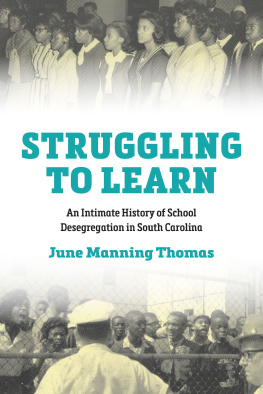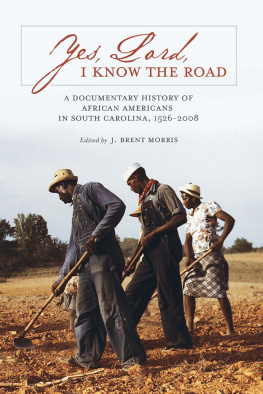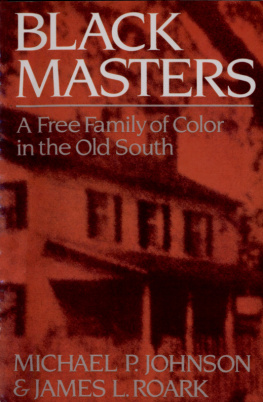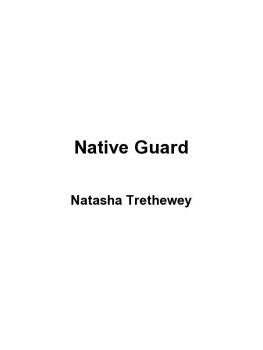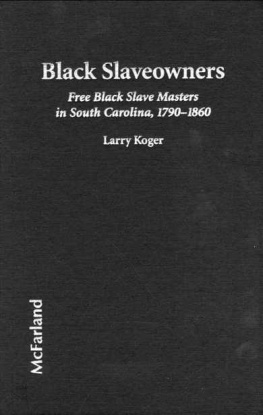

Published by The History Press
Charleston, SC 29403
www.historypress.net
Copyright 2009 by Damon L. Fordham
All rights reserved
Images are courtesy of the author unless otherwise noted.
First published 2009
e-book edition 2013
Manufactured in the United States
ISBN 978.1.62584.299.2
Library of Congress Cataloging-in-Publication Data
Fordham, Damon L.
Voices of black South Carolina : legend and legacy / Damon L. Fordham.
p. cm.
print edition ISBN 978-1-59629-611-4
1. African Americans--South Carolina--Biography--Anecdotes. 2. African Americans--South Carolina--History--Anecdotes. I. Title.
E185.93.S7F673 2009
920.0092960730757--dc22
2008052164
Notice: The information in this book is true and complete to the best of our knowledge. It is offered without guarantee on the part of the author or The History Press. The author and The History Press disclaim all liability in connection with the use of this book.
All rights reserved. No part of this book may be reproduced or transmitted in any form whatsoever without prior written permission from the publisher except in the case of brief quotations embodied in critical articles and reviews.
CONTENTS
ACKNOWLEDGEMENTS
Many thanks go to my parents for adopting and raising me; to my immediate and extended family in Mt. Pleasant, South Carolina, for a lifetime of support; and to my sister, Bobbie, and all of her children and grandchildren. I also extend a special acknowledgement to my biological relatives and extended family in Spartanburg, South Carolina, and across the rest of the United States and the West Indies.
Further acknowledgement goes to my mentors Dean Willie Harriford of the University of South Carolina, Mr. Joseph Kimpson of Carver High School in Spartanburg and Mr. Harold Brunson of Wando High School in Mt. Pleasant; also to Dr. W. Marvin Dulaney, Dr. Jack Bass, Dr. Bernard Powers and Dr. Edmund Lee Drago of the College of Charleston for their advice on this book. Extra thanks to archivist Harlan Greene, Georgette Mayo, Deborah Wright, Curtis Franks and Jessica Lancia at the Avery Research Center and Graham Duncan of Caroliniana Library. For their interviews and other assistance, thanks to Carl Gathers, Philip Simmons, Raymond Junie Scott, Sherry Gadsden, Sonya McGowan, Beulah Petty, Gigail Petty, LaVern Reid, Patricia Mallett, Cynthia McCottry Smith, Barney Blakeney, William E. Rouse and Frances E. Saunders.
A special thanks also goes out to everyone who purchased and critiqued my previous volume, True Stories of Black South Carolina. I hope you will enjoy this also.
INTRODUCTION
This book is not intended as a formal history of blacks in South Carolina; rather, it is a collection of stories written by the author about this subject.
Over the last decade as a historian I conducted a number of research projects. Often, I found fascinating stories about black South Carolinians as I searched through research materials, and I would save these stories for future use. This book is that future use. Additionally, I was a columnist for an African American weekly newspaper known as the Charleston Coastal Times from 1994 until the paper was discontinued in 1998. On weeks where there was little of note to write about, I would compose columns about interesting local people and incidents of the past or present. Three of those articles begin this book.
As was the case with True Stories of Black South Carolina, this book concentrates on the lesser-known episodes of this genre that, in some cases, are known to South Carolina historians but are not widely recognized among the general public. It is hoped that this book will help to make these stories available and accessible to the general reader.
PASSING IT ON
I recently had an unexpected surprise. I was on my way to a local butcher to get some meat when I ran into Barney Blakeney, the local columnist known for his articles in the Charleston Chronicle and the Columbia Black Times.
We had a pretty good conversation. I told him how much I have enjoyed reading his Black to Black and As I See It columns since I was a teenager, and he replied that he also thought highly of my work and was proud to have been an influence on me. After we exchanged numbers and agreed to meet again, he said, Dame, Im going to tell you like my coach, Joseph Pop Moore, told me when I was at C.A. Brown High SchoolPass it on, brother. Thats what its all about.
These words came again to my mind a week later.
I am one of the instructors in the Avery Scholars Program, which is an after-school program at the Avery Research Center of African American History here in Charleston that teaches fifth graders about their history, culture and good citizenship. Last week, we took the children on a field trip to meet the legendary blacksmith Mr. Philip Simmons.
Mr. Simmons, who is best known for his classic artwork that graces many gates in Charleston, was born in 1912 on nearby Daniel Island, where he was raised mostly by his grandparents. His biographer John Vlach, in his book Charleston BlacksmithThe Work of Philip Simmons, noted that because the schools for black children in that area opened irregularly for a few months a year, Simmons was sent about 1920 to live with his parents in Charleston, where he could receive a more stable education. However, he attended the citys Buist Elementary School only for a few years until his father died in the early 1920s.

The gate at Buist Academy by Philip Simmons. Simmons attended elementary school here in 1921. Courtesy of the author.
Fortunately, in 1925, at the age of thirteen, he passed the blacksmith shop of Peter Simmons (no relation) and was enthralled by the sight of the older man beating the red hot iron and the sparks flying. He began by helping the elder Mr. Simmons, who was born into slavery in 1855, clean up his shop, and this led to an apprenticeship. Peter Simmons had learned the blacksmithing trade from his father, a slave named Guy Simmons, who may have, in turn, learned it from African ancestors, as this trade was practiced in some countries along Africas West Coast. Peter Simmons told his young mentee that his father would sometimes hit him with a hammer for making mistakes with this work, although Peter never did this to Philip.
As an adult, Philip went on to own his own shop and became so well known for his skill in making fancy designs for gates that he received honors from President Ronald Reagan, the South Carolina Hall of Fame and the Smithsonian Institution in Washington, D.C. But the most amazing thing about Mr. Simmons is the fact that, as of this writing, he continues to practice his craft at his advanced age, as well as his humility in the face of his fame.
As with many of his age, Mr. Simmons is a treasure chest of wisdom. While showing the children his awards and the picture of himself with President Reagan, he pointed to an engraving that displayed a motto that he loves to quote. It was a cartoon of a man praying below the inscription, Its good to pray, but when you finishyouve got to get up off your knees and hustle!
I thought back to my first encounter with Mr. Simmons. Not long ago, I was assigned by the Charleston Coastal Times to cover a party with some celebrities in a mansion along South of Broad (a wealthy neighborhood in Charleston). I was bored and annoyed with the stiffness and pretentiousness of this affair until I noticed something interesting. There sat Mr. Philip Simmons in a tuxedo as the wealthy movers and shakers of Charleston surrounded him to imbibe from his wisdom.
Next page
